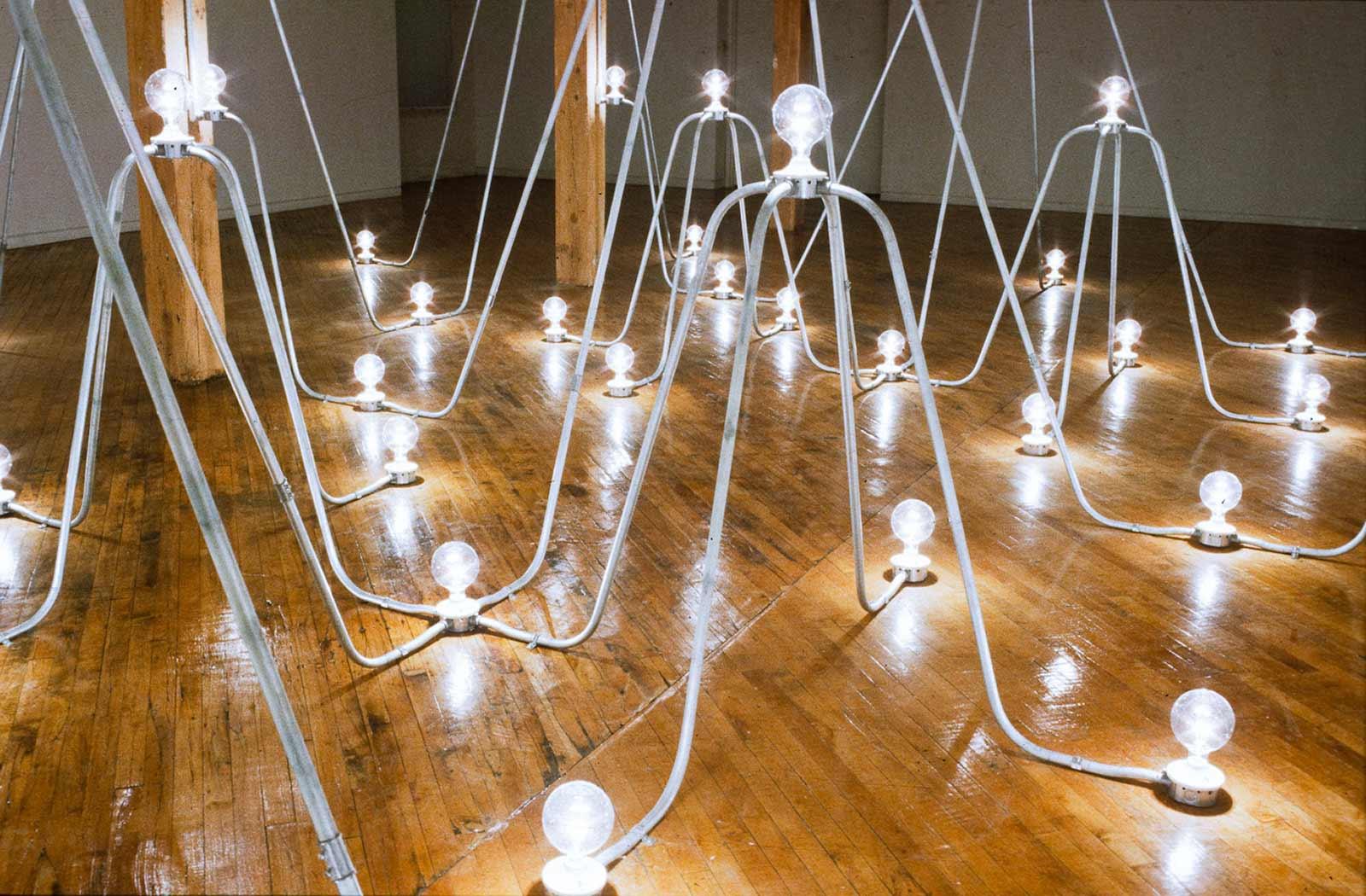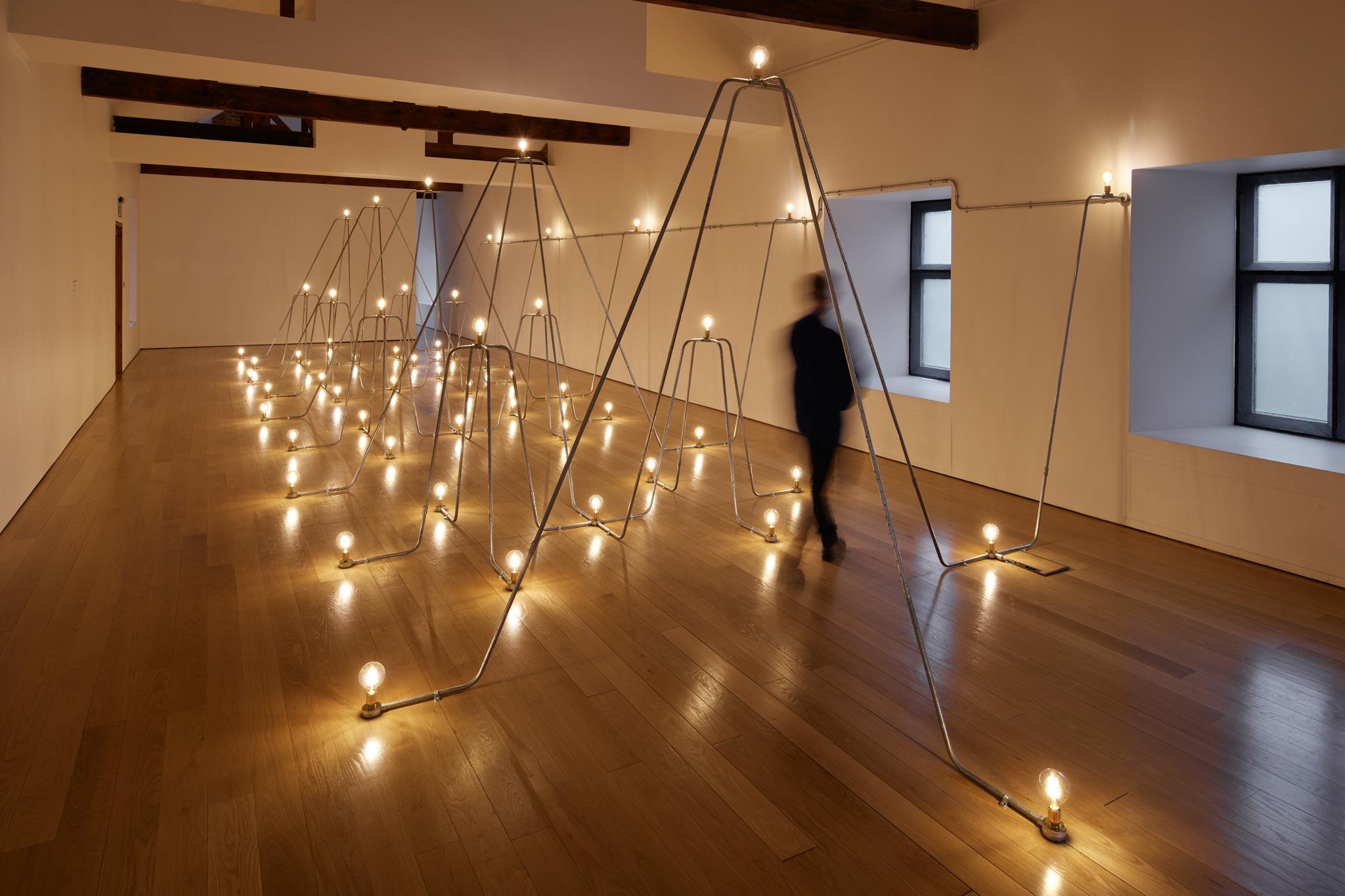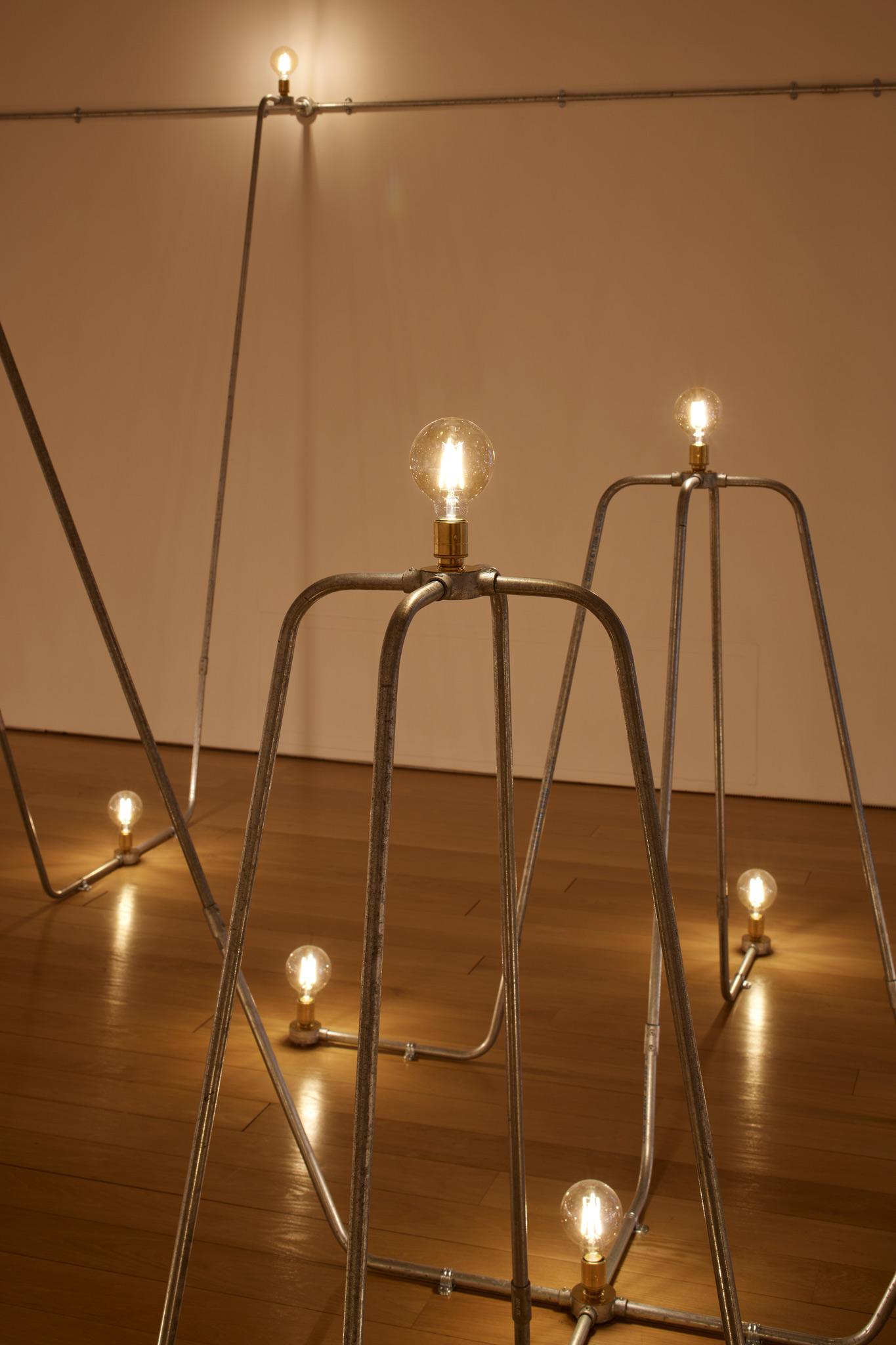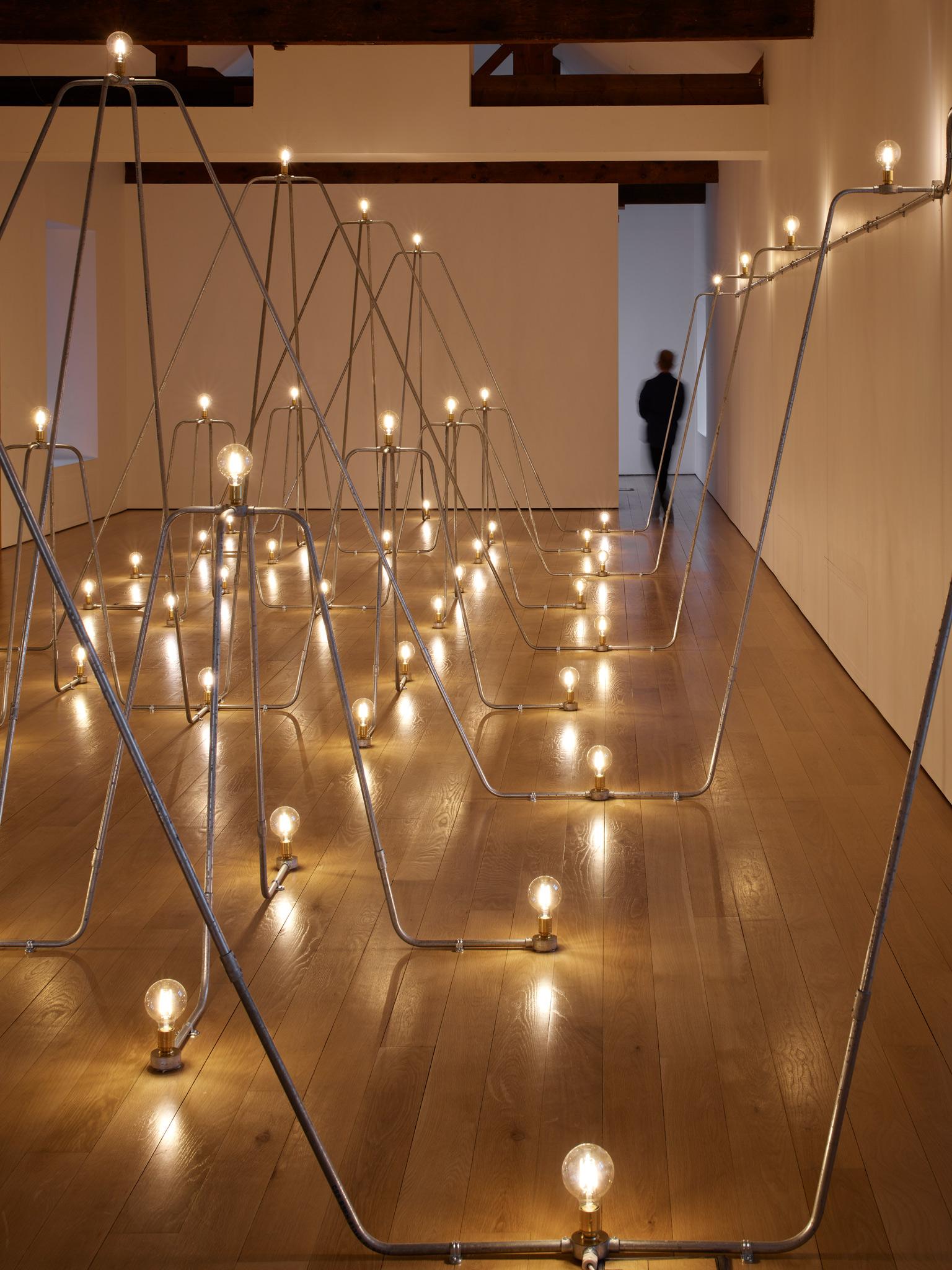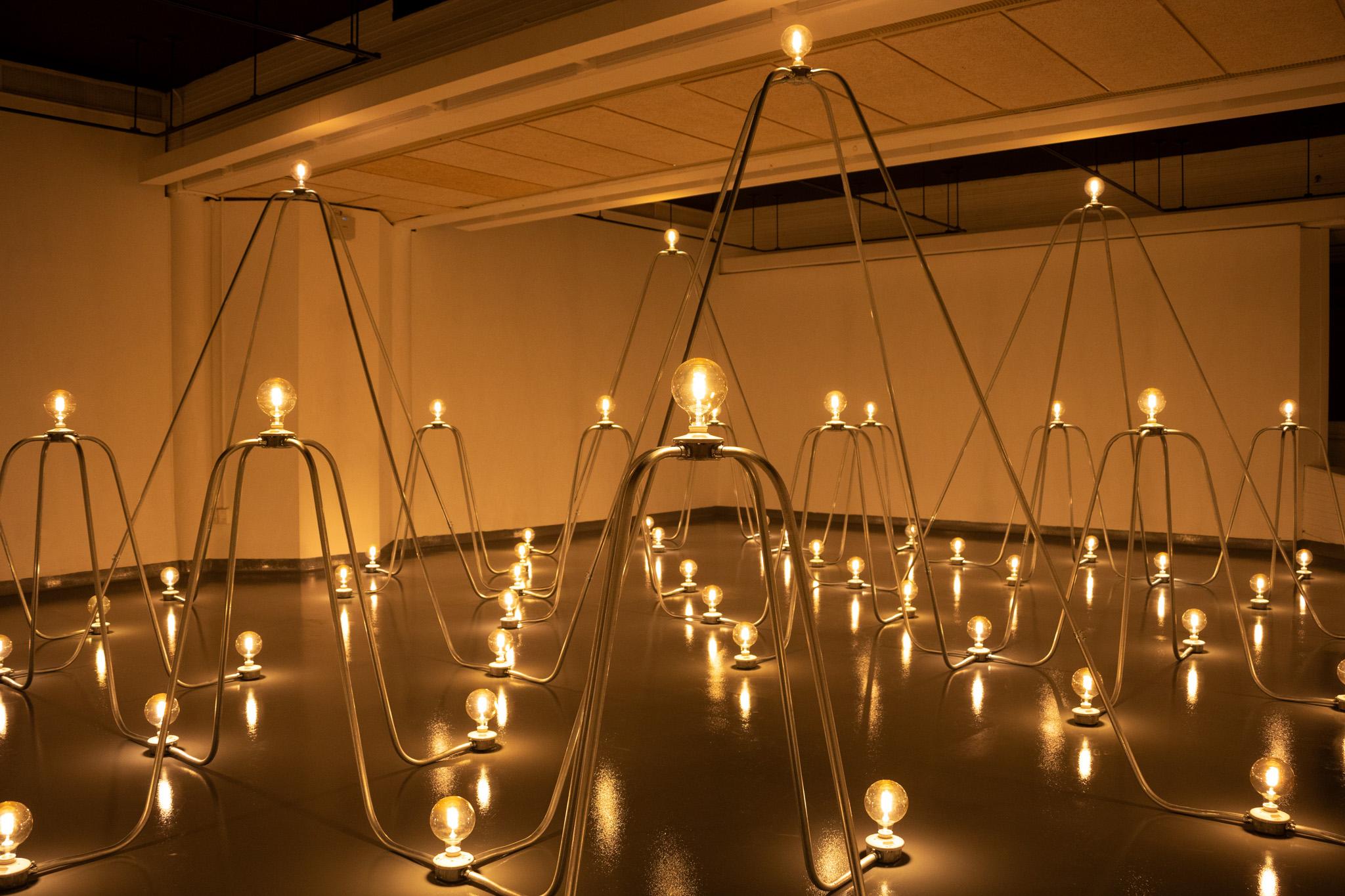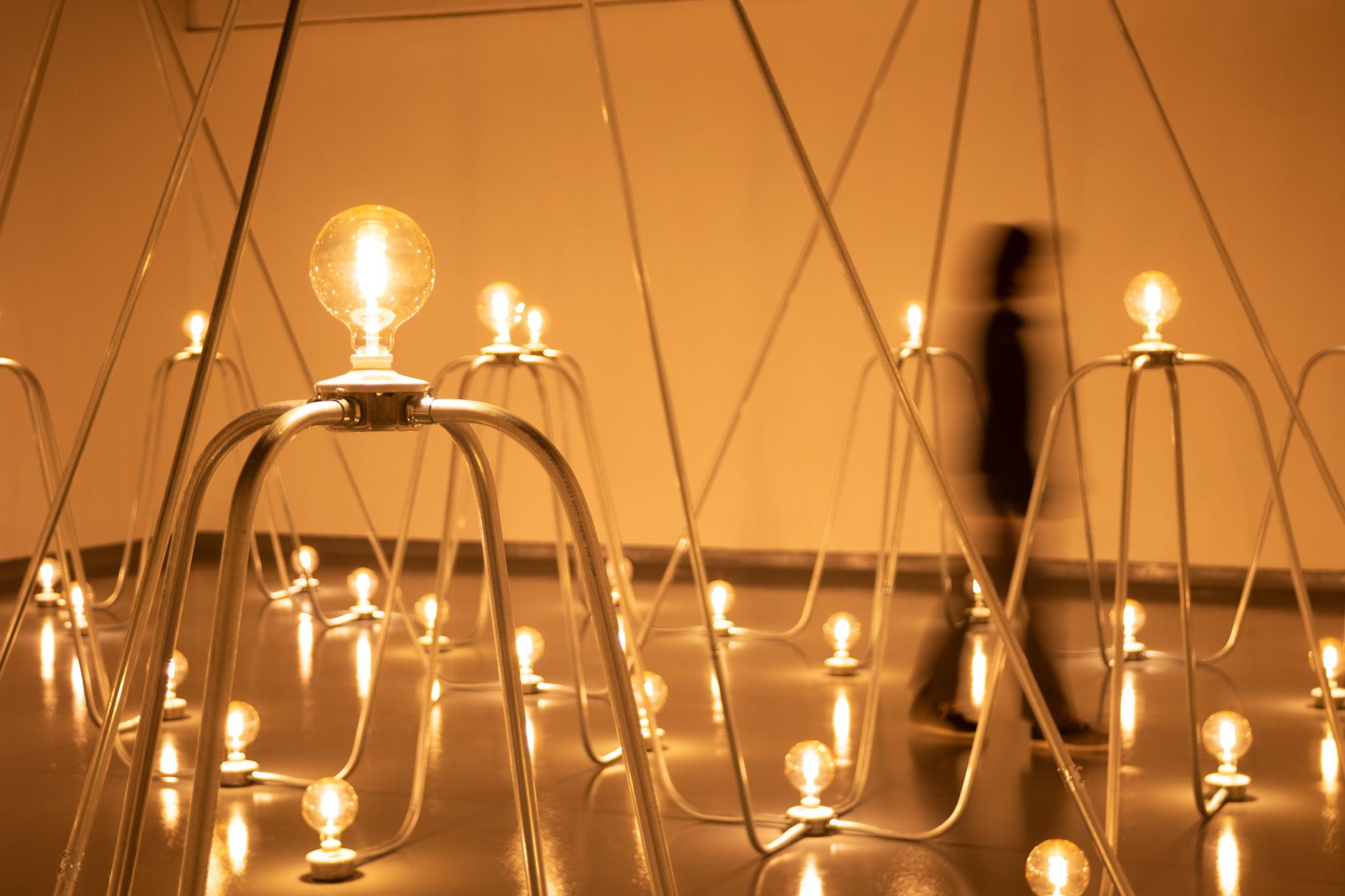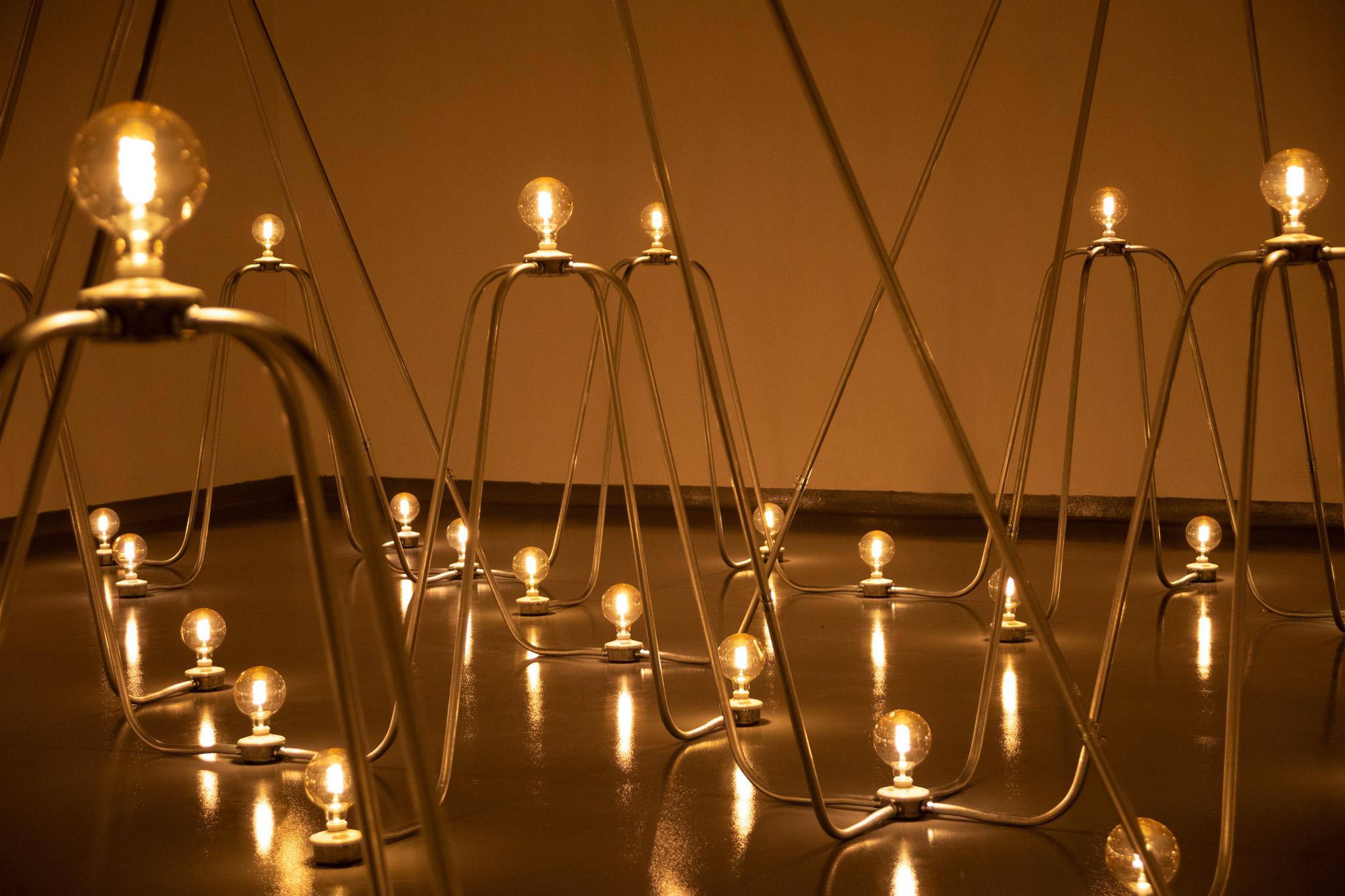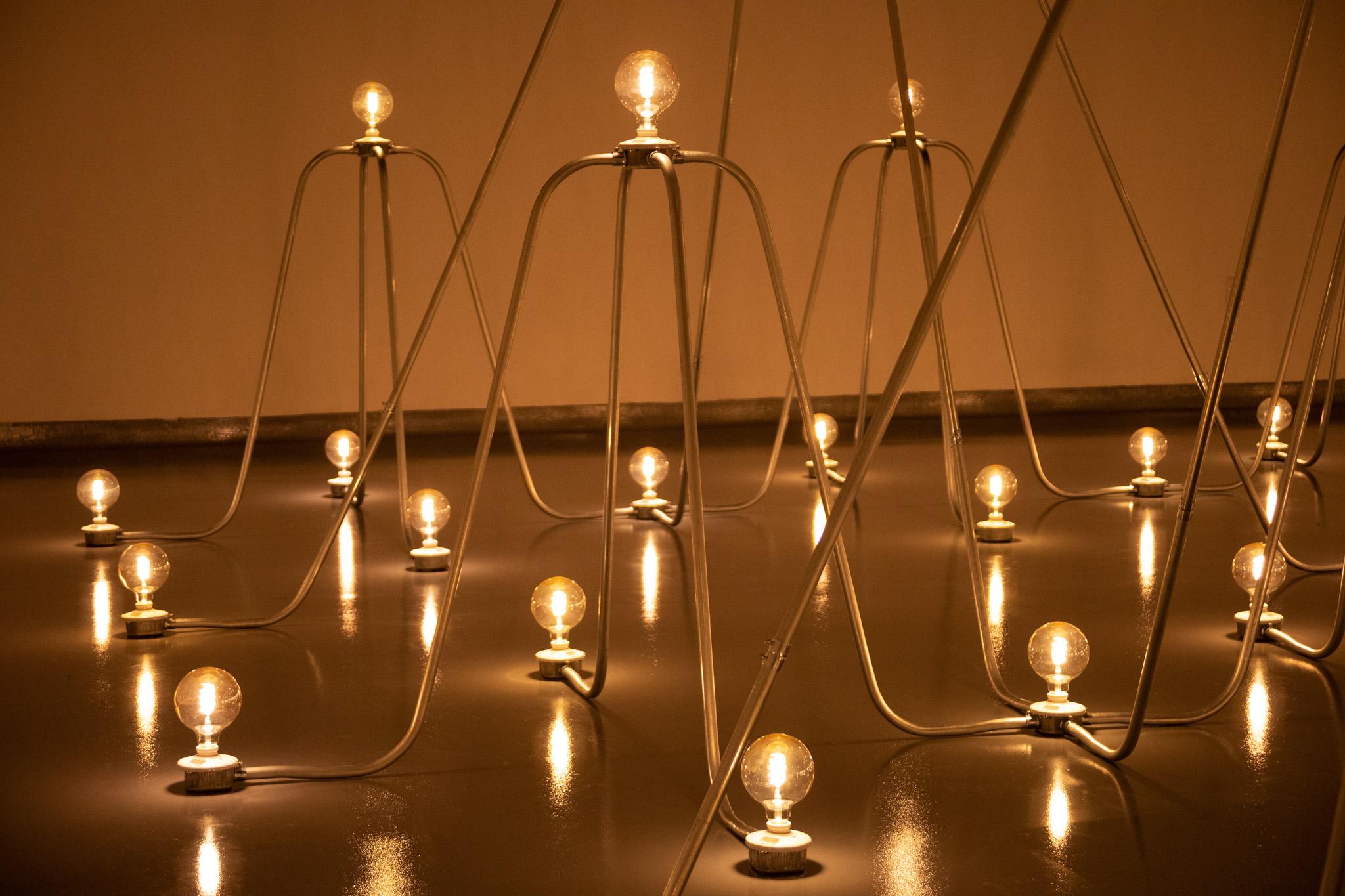Electrical System: An Archaeology of an Artwork
How do you present a site-responsive installation in a new location when the artist who created the work cannot be consulted? For Nancy Holt’s Electrical System, this was the exact question that had to be asked. Holt presented this room-sized artwork in New York City and Toronto in 1982. Its legacy lives in drawings and installation images, as well as in her lectures, writings, and interviews. Electrical System belongs with a body of site-responsive sculptures Holt named System Works: sculptures constructed of standard industrial materials that interact with the architecture and existing technological systems of the exhibition space. The sculptures call attention to all the systems—industrial, environmental, and economic—that power the buildings in which they were exhibited. In 2021, Holt/Smithson Foundation made the first posthumous presentation of Electrical System in the exhibition Light and Language at Lismore Castle Arts, which involved a careful set of considerations. First, we needed to ask if the sculpture could, and more importantly, should be shown some forty years after it had last been seen. Realizing Electrical System at Lismore Castle Arts unearthed countless questions at each bend in the two-year planning process, leading to new understandings of this important work in Holt’s oeuvre.
The first step in considering if Electrical System could be shown seven years after Nancy Holt had passed was to think about her artistic practice holistically and examine her process of thinking as she developed the work. Nancy Holt was an artist who consistently questioned the systems that shape the world. Examining systems of language, place, and vision guided the series of works Holt created that directly preceded Electrical System, including her concrete poems, photoworks, Locators, and early earthworks. Electrical System builds on the ideas in Holt’s earthworks made in the landscape during the 1970s—synthesizing her interest in light, industrial materials, ecological concerns, and architecture by creating sculpture in the built environment.1 To bring these ideas into material form, Holt built the first two small test units in her loft on Greenwich Street, New York City in 1981. This initial experiment was constructed of standard three-quarter inch electric metallic tube conduit, junction boxes, metal conduit straps, and large clear globe lightbulbs. Holt built one freestanding tower with four legs and four bulbs, and another unit connecting two walls with conduit that arched down to a bulb on the floor and back up to high bulbs on both walls. In these studio tests she used her living space as a laboratory to create the basic units of the system that would then be expanded into more complex installations out in the world.
The first public presentation of Electrical System took place the following year at John Weber Gallery, in New York City. Holt combined the towers and arches from her studio experiments to create an undulating network of conduit and light wrapping around all four walls of the gallery, with soaring arches and tall towers enveloping the visitor on entry. Movement through the space was encouraged and a standard light switch on one wall allowed the work to be turned on and off at will. Holt titled the work Electrical System (for Thomas Edison), alluding to the American inventor as well as the New York City energy company and power station ConEd.2 Later that year Holt created Electrical System II: Bellman Circuit at David Bellman Gallery in Toronto. Here Holt used the same building blocks of towers and arches to create a system that responded to the architecture of the space, interacting with four columns along a central spine. In both iterations the light from Electrical System reflected off the floor, walls, and ceiling, illuminating the space and calling attention to architectural details. As Holt described in a 1986 lecture: “the system is also functional, the light that is being produced is lighting the gallery.”3
One possibility for presenting Electrical System at Lismore Castle Arts was to recreate one of the exhibition spaces from 1982 inside of the castle, attempting to match the dimensions, materials, and layout of the system. After much discussion, we concluded attempting to recreate either of the previous iterations would render Electrical System a relic: a network of lights illuminating a falsity. A reconstructed space could never capture the true material nature or infrastructural circumstances of the previous exhibition spaces; Electrical System needs to interact with each building’s unique systems, structure, and materials rather than a façade obscuring this reality. Holt was clear that her System Works “are not things in themselves that begin and end in a gallery or outdoor site; they’re a part of a huge network of interconnected conduit systems often deep within the ground or in the walls of buildings.”4 We concluded that creating a facsimile of an exhibition space inside of another space would undermine Holt’s primary intention for the work to be an honest, functional part of a larger whole. The alternative route—the one taken for Light and Language, and for all subsequent presentations5 —is to carefully study the logic of Electrical System and apply this to the exhibition space at Lismore Castle Arts. We began with a close study of Holt’s drawings, writings, and images relating to the work. Holt’s scrawled calculations and revisions in the margins of these drawings provide an insight into her working process and the highly technical aspect of this work. As with Holt’s Locators, Sun Tunnels (1973-76), and other large-scale installations, her fastidious technical preparation resulted in a finished work that is aesthetically intuitive—the result of refining an idea and materials down to a core concept and form that invites the visitor to perceive and experience. The elegant spans of conduit in Electrical System follow the logic and language of conventional electrical work yet have a distinct and dynamic sculptural quality. As Holt wrote, “I intend the work to be practical yet playful, functional yet not really necessary.”6
After identifying the basic building blocks of the system and their specifications, the Foundation team worked with an electrician at the Foundation’s home base in New Mexico to build prototypes to understand the fabrication process and the scale of the work. Learnings from these tests were applied to the space of Lismore Castle to create a ground plan for Electrical System, working with Paul McAree, Curator of Lismore Castle Arts, and Edward and John Fenton, the Castle’s electricians, to consider the layout of the work in relation to the exhibition space. Our next major question concerned materials: should we use standard American or Irish electrical materials? Holt wrote that the System Works are “made of the standard materials of each system.”7 When asked about her process, Holt stated the System Works were “all done to code–exactly the way you would do any functioning electrical or plumbing system,”8 ensuring that her work would adhere to the systems we exist in to achieve her intention to expose “fragments of vast, hidden networks” that are “ part of open-ended systems, part of the world.”9 Following her guidance that the work should be constructed of standard materials and be part of an existing system, we felt confident Electrical System should use Irish conduit, fasteners, and junction boxes. This decision had a subtle, and distinct, aesthetic impact on the work. Irish conduit is thicker and less pliable than US conduit, and thus does not use an offset bend to connect with the junction boxes and the conduit straps are designed to enable this by elevating the conduit slightly above the floor and walls. In 1982 Holt used American porcelain plate covers for the junction boxes and in Ireland the standard material is brass. The lightbulbs were also an issue. In 1982 they were incandescent, but in 2021 LED bulbs were a better choice as they are more energy efficient, and—again—standard. Holt specified the “lightbulbs are the kind that show the arc of electricity…you were conscious of the electricity”; sourcing LED bulbs designed to mimic an incandescent bulb with a visible filament was an essential compromise.10 Adhering to local building codes and using locally sourced materials that tie directly into the flow of electricity powering Lismore Castle kept the key concept of the work alive, while also leading into aesthetic territory that Holt did not explore during her lifetime.
In these moments of venturing the uncharted waters with Electrical System as we presented the work at Lismore Castle, it was tempting to ask: what would Nancy do? This line of thinking is fraught with assumptions; no matter how closely we study Holt’s work we can never replicate the thoughts and reactions she would have to a space. Instead, we must rely on the logic of the systems Holt designed, and more importantly, her trust in the people she collaborated with to construct her work. Holt clearly stated that in all instances, “I work with local materials and local craftspeople in building my work.”11 The contractors that built Holt’s works were not a means to an end for Holt; she considered these workers collaborators who were an integral part of the process. As Electrical System took shape at Lismore Castle Arts, we relied on the expertise of electricians Edward and John Fenton when faced with a decision about the appearance of Electrical System that had no historical precedent. Following Holt’s trust in the people who fabricated her work and live and breathe these systems daily ensures the work maintains the logic of the standard electrical system.
Presenting Electrical System as a dynamic site-responsive work is more precarious, and more rewarding, than presenting a replica of the work. There is risk in exploring the boundaries of the work, however the questions that this process exposed have led to a more nuanced understanding of Electrical System and Holt’s approach to systems, light, and space. Nancy Holt was a bold artist who never shied from ambitious projects, new media, and the lack of control inherent in collaboration. It is only right that a Foundation in her name honors her boldness in our quest to share her works and ideas with the world. Presenting Electrical System in 2021 involved navigating a pandemic through an international team effort, using digital conference calls and videos to consider minute details of the installation. The process feels in step with Holt’s embrace of new media and collaboration throughout her life. There are undoubtedly many blind spots in our approach that will be illuminated through the critical questions and responses to those that experience Electrical System.
Selected Bibliography
Holt, Nancy. “Ventilation Series.” In Nancy Holt: Sightlines, edited by Alena J. Williams, University of California Press, 2011, pg 144. Originally published as “Nancy Holt: Ventilation Series” in Christina M. Strassfield, Volume 6 Contemporary Sculptors, exhibition catalogue, unpaginated (East Hampton, N.Y.: Guild Hall Museum, 1992).
Marter, Joan. “Systems: A conversation with Nancy Holt,” Sculpture Magazine vol. 32, no. 8 (October, 2013).
Williams, Alena J. (ed.) Nancy Holt: Sightlines (Berkeley: University of California Press, 2011).
About the Author
William T. Carson is the Program Manager & Assistant Curator at Holt/Smithson Foundation, which he joined in 2019. William is an artist whose work considers cultural relationships to fossil fuels and raises questions about how we value natural materials. Growing up on a cattle ranch in rural Montana surrounded by coal mines inspired William’s interest in working with coal to create paintings, sculptures, sound performances, and time-based installations. William studied architecture at the Danish Institute for Study Abroad in Copenhagen, Denmark, and in 2015 he graduated from Colorado College with Distinction in Art Studio. William has exhibited at the Missoula Art Museum, the Salina Biennial, and is represented by Nüart Gallery in Santa Fe, NM and Camiba Gallery in Austin, TX.
- 1In an interview with Joan Marter in 2013, Holt spoke about the direct connection between Sun Tunnels and the System Works: “I’m interested in bringing the universe to the human being. There is a strong connection between Sun Tunnels and these system pieces because Sun Tunnels is part of a system as well, the solar system.”
Marter, Joan. “Systems: A conversation with Nancy Holt,” Sculpture Magazine vol. 32, no. 8 (October, 2013).
- 2 Ibid.
- 3Holt, Nancy. “Nancy Holt (October 22, 1986).” SCI-Arc Media Archive. Video of an artist lecture, 31:37 to 31:44, https://www.youtube.com/watch?v=Uz4uq89QKaQ&t=4431s. Accessed April 12, 2021.
- 4Marter, “Systems: A conversation with Nancy Holt.”
- 5Since the Lismore Castle Arts presentation, Electrical System has been exhibited by Holt/Smithson Foundation at UMass Dartmouth in 2021 and at Sprüth Magers, Los Angeles in 2022.
- 6Holt, Nancy. “Ventilation Series.” In Nancy Holt: Sightlines, edited by Alena J. Williams, University of California Press, 2011, pg 144. Originally published as “Nancy Holt: Ventilation Series” in Christina M. Strassfield, Volume 6.
- 7Ibid.
- 8Marter, “Systems: A conversation with Nancy Holt.”
- 9Holt, “Ventilation Series.”
- 10Holt, “Nancy Holt (October 22, 1986).” 32:29 to 32:41.
- 11Holt, Nancy. Unpublished expression of interest in the creation of a public sculpture on the campus of Washington State University, Pullman. Date unknown, likely between 1980 and 1989.
Carson, William T. "'Electrical System': An Archaeology of an Artwork." Holt/Smithson Foundation: Scholarly Texts Chapter 4 (October 2022). https://holtsmithsonfoundation.org/electrical-system-archaeology-artwork.

